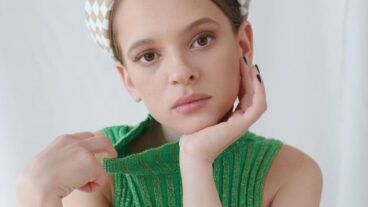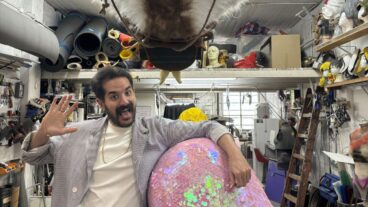Sergey Bunkov grew up in Russia and immigrated to Israel at the turn of the millennium. Buthina Abu Milhelm is from an Israeli Arab village in the Wadi Ara region. Both are artists, specializing in the decorative arts.
No, they aren’t exactly household names. Yet.
But that could change very soon. Along with seven other select Israeli artists, Bunkov and Abu Milhelm are about to become much better known in the international art community. Their works will be shown together in a special exhibit at the prestigious SOFA (Sculpture Objects & Functional Art) Expo, to be held at the Navy Pier in Chicago from October 28-30.
SOFA Chicago is an annual event that draws approximately 35,000 visitors each year, including influential collectors, galleries and museum curators. For the past three years, Israel has presented special exhibits at SOFA Chicago, under the auspices of the Association of Israel’s Decorative Arts (AIDA).
AIDA is the brainchild of American collectors Doug and Dale Anderson, and Canadian/Israeli philanthropists Charles and Andy Bronfman. AIDA was formed at the height of the recent intifada, when tourism to Israel waned and Israeli artists were having difficulty finding a market for their creations.
Like a skilled matchmaker, AIDA brings Israeli artists producing museum-quality art together with dealers and galleries, and for the past three years, bringing Israeli artists to participate at SOFA Chicago has been an important part of what they do.
Joining Abu Milhelm and Bunkov at SOFA Chicago this year will be fellow Israeli artists Michal Alon (ceramics), Shirly Bar-Amotz (glass), Gali Cnaani-Sherman (textiles), Einat Cohen (ceramics), Rory Hooper (jewelry), Dina Kahana-Gueler (jewelry), and Alon Eliezer Meron (ceramics).
Some of the Israeli artists in the exhibition have been producing art for decades, while others are newcomers, with only a few years of experience. The group’s common denominator is their collective passion to innovate.
The exhibit to be shown at SOFA Chicago is entitled ‘Updating Traditions.’ Perhaps most exciting about this year’s AIDA exhibit is that, with the addition of Abu-Milhelm’s work, those diverse artistic traditions include those of the Israeli Arab community.
Abu-Milhelm specializes in textile art and is bringing eight artworks to SOFA, each utilizing a white background filled with traditional Arab embroidery.
“I think there is something different in my works, which emerges directly from the culture and the environment in which I live,” she told ISRAEL21c, citing her art classes at the Art Center in her village as inspiring her in this direction.
Living in a country where cultural differences have often led to conflict, Abu-Milhelm sees art as a neutral ground, which stands on its own merits.
“When it comes to art, there’s no distinction between Arab and Jewish, or Israeli and Palestinian,” Abu-Milhelm says, “the art speaks for itself.”
Bunkov, for his part, helps explain what his art – industrial designs featuring sandblasting on glass – is saying.
“There’s a philosophical statement in the art. The pictures are full of color and life, people drinking wine, pregnant women, and they’re juxtaposed with the fragility of glass. It could break in a second,” Bunkov says.
“This to me shows that the world is fragile, and we have to hold onto the happiness that we can,” he says.
Abu-Milhelm, the Israeli Arab, and Bunkov, the Russian immigrant, work in vastly different mediums but on one issue they stand as one: pride in representing their nation.
“I feel very proud to represent Israel,” says Abu-Milhelm, and expressed pleasure at being selected to join this highly exclusive exhibit.
“I’m very proud to be representing Israel,” echos Bunkov says, and also expresses his appreciation for AIDA. “In Russia, it was very hard to get recognition outside the country.”
Working together with AIDA, Bunkov now has good reason to be optimistic. Doug Anderson estimates at least half of the artists AIDA has worked with in the past have been matched with dealers, and AIDA continues to help the others.
“I think our batting average has been terrific!” says Anderson.
Some of the artists AIDA has helped have already found tremendous success. Michal Zahavi and Dafna Kaffeman were part of AIDA’s first exhibition at SOFA in 2003. Today, ceramicist Zahavi has become a top seller at the R. Duane Reed galleries in New York and St. Louis, while glassworks specialist Kaffeman’s works have been added to the collection at the Corning Museum of Glass and the Racine Art Museum. In addition, Kaffeman has won numerous scholarships and her works are shown in several galleries.
“In three years… [Kaffeman] has become quite a star,” Anderson says. She is now represented by the Heller Gallery in New York, the Bullseye Gallery in Portland Oregon and a gallery in Berlin.
Matching artists and dealers is never easy, explains Anderson. A trusting relationship must be forged between an artist, who must reliably deliver the art, and a gallery, which must reliably promote the art and timely compensate the artist. In the art world, there are agents that provide a similar ‘matchmaking’ service – for a price. AIDA is a purely philanthropic endeavor.
(David Brinn contributed to this report)












